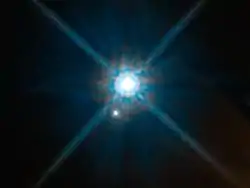Stein 2051
Stein 2051 (Gliese 169.1, G 175-034, LHS 26/27) is a nearby binary star system, containing a red dwarf (component A) and a degenerate star (white dwarf) (component B), located in constellation Camelopardalis at about 18 ly from Earth.[8]
| Observation data Epoch J2000 Equinox J2000 | |
|---|---|
| Constellation | Camelopardalis |
| Stein 2051 A | |
| Right ascension | 04h 31m 11.5181s[2] |
| Declination | +58° 58′ 37.461″[2] |
| Apparent magnitude (V) | 10.977[2] |
| Stein 2051 B | |
| Right ascension | 04h 31m 12.570s[3] |
| Declination | +58° 58′ 41.15″[3] |
| Apparent magnitude (V) | 11.19[3] |
| Characteristics | |
| Stein 2051 A | |
| Spectral type | M4.0Ve[2] |
| U−B color index | +1.21[4] |
| B−V color index | +1.65[4] |
| Stein 2051 B | |
| Spectral type | DC5[3] |
| U−B color index | -0.53[4] |
| B−V color index | +0.31[4] |
| Astrometry | |
| Stein 2051 A | |
| Radial velocity (Rv) | 29 km/s |
| Proper motion (μ) | RA: 1300.2[5] mas/yr Dec.: -2049.0[5] mas/yr |
| Parallax (π) | 180 ± 0.8[2] mas |
| Distance | 18.12 ± 0.08 ly (5.56 ± 0.02 pc) |
| Stein 2051 B | |
| Radial velocity (Rv) | 2.0 km/s |
| Proper motion (μ) | RA: 1335.6[5] mas/yr Dec.: -1962.6[5] mas/yr |
| Parallax (π) | 179 ± 3[3] mas |
| Distance | 18.2 ± 0.3 ly (5.59 ± 0.09 pc) |
| Other designations | |
| Stein 2051 A: LHS 26, NLTT 13373, TYC 3744-412-1, 2MASS J04311147+585837, WISE J043113.20+585816.7[2] | |
| Stein 2051 B: EGGR 180, LHS 27, NLTT 13375, TYC 3744-2062-1, 2MASS J04311201+5858476, WD 0426+58, WD2 0426+585, WD3 0426+588[3] | |
| Database references | |
| SIMBAD | The system |
| A | |
| B | |
Stein 2051 is the nearest (red dwarf + white dwarf) separate binary system (40 Eridani BC is located closer at 16.26 light-years,[9] but it is a part of a triple star system).
Stein 2051 B is the 6th nearest white dwarf after Sirius B, Procyon B, van Maanen's star, LP 145-141 and 40 Eridani B.
Properties
The brighter of this two stars is A (a red dwarf), but the more massive is component B (a white dwarf).
In 2017, Stein 2051 B was observed passing in front of a more distant star. The bending of starlight by the gravitational field of the nearer star allowed its mass to be directly measured. The estimated mass of Stein 2051 B is 0.675±0.051 M☉, which fits the expected range of a white dwarf with a carbon-oxygen core.[10]
References
- "Einstein revisited". www.spacetelescope.org. Retrieved 12 June 2017.
- "NAME Stein 2051 A". SIMBAD. Centre de données astronomiques de Strasbourg. Retrieved 26 December 2016.
- "NAME Stein 2051 B". SIMBAD. Centre de données astronomiques de Strasbourg. Retrieved 20 December 2016.
- Hardie, R. H. (1966). "UBV Photometry of the Lowell Proper Motion Object G175-34". Publications of the Astronomical Society of the Pacific. 78 (462): 171. Bibcode:1966PASP...78..171H. doi:10.1086/128321.
- Zacharias, N. (2012). "The fourth US Naval Observatory CCD Astrograph Catalog (UCAC4)". VizieR On-line Data Catalog. Bibcode:2012yCat.1322....0Z.
- Perryman; et al. (1997). "HIP 21088". The Hipparcos and Tycho Catalogues. Retrieved 2014-11-23.
- Gliese, W. & Jahreiß, H. (1991). "Gl 169.1". Preliminary Version of the Third Catalogue of Nearby Stars. Retrieved 2014-11-23.
- Van Altena W. F.; Lee J. T.; Hoffleit E. D. (1995). "GCTP 986.01". The General Catalogue of Trigonometric Stellar Parallaxes (Fourth ed.). Retrieved 2014-11-23.
- Perryman; et al. (1997). "HIP 19849". The Hipparcos and Tycho Catalogues. Retrieved 2014-11-21.
- Sahu, Kailash C.; et al. (June 2017), "Relativistic deflection of background starlight measures the mass of a nearby white dwarf star", Science, 356 (6342): 1046–1050, arXiv:1706.02037, Bibcode:2017Sci...356.1046S, doi:10.1126/science.aal2879, PMID 28592430, S2CID 206654918.
External links
- "CCDM J04312+5858AB -- Double or multiple star". Centre de Données astronomiques de Strasbourg. Retrieved 2012-01-02. (the whole system)
- "NAME STEIN 2051A -- Star in double system". Centre de Données astronomiques de Strasbourg. Retrieved 2012-01-02. (component A)
- "GJ 169.1 B -- Star in double system". Centre de Données astronomiques de Strasbourg. Retrieved 2012-01-02. (component B)

